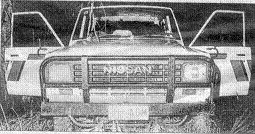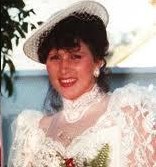
The Crime Scene.
Following a third inquest begun on 14/11/2011, the coroner Mr Michael Barnes handed down on 1/3/2013 his decision to commit Alan Leahy to stand trial for murder. A judgement that contradicts the previous two coroner's judgements, supports my challenge to those verdicts, but which was subsequently set aside.

The Crime Scene.
A vehicle discovered stuck in remote bush at Cherry Creek, Atherton, North Queensland on July 26, 1991, contained two dead females. The body of Julie-Anne Leahy, 26, was in the driving seat with two bullet wounds, both fired into the side of her head, with the non-fatal shot going down through the jaw and exiting from her neck. Around her neck was wrapped her seat belt. On her throat were incisions by a knife. She had also been struck on the side of her head with a rock and some of the fingers on her left hand were broken.
The other corpse, Vicki Arnold, 28, was without shoes, and had been shot three times; one shot fired into the top front of her thigh, and not discovered until the autopsy and after the police had decided the nature of the crime; one shot was fired from close range into her head from underneath her chin; the third and fatal shot was fired into her head from behind her ear.
A bullet had been fired from the rear of the vehicle, through the passenger's front seat. On the cabin floor was a rock and a bent fishing knife. Some twenty metres from the vehicle, but not together, were Vicki Arnold's shoes.
The weapon used was a cut-down .22 rifle, an alteration that negated the automatic reload which meant manually cocking before each discharge. The rifle was discovered with the mechanism jammed, and in the hand of Vicki Arnold — a startling discovery since suicide victims are rarely found holding the weapon.

Vicky Arnold

Julie-Anne Leahy
The Coroners' Verdicts
On Monday 21st February 2000, following a second inquest into the deaths of the two women the coroner ruled murder/suicide. Mr Casey found that the evidence confirmed the 1992 judgement of Coroner Spicer Hamilton that Vicki Arnold murdered her friend Julie-Anne Leahy then turned her weapon on herself. A verdict that depended upon the obscure motive of unrequited homosexual love, and left a murder scene that defied any simple explanation.
When the evidence is not sufficient to rule on the events, the coroner has the option to hand down an open verdict, and leave the case as unresolved. Neither judge felt the evidence left any doubt as to what happened, despite the fact that they could not say themselves what actually occurred; which of course is doubt. The multiple and inexplicable wounds in both bodies, along with the absence of any clear motive should be sufficient reason to doubt a murder-suicide verdict, but Casey and Spicer claim this is not the case. They have invoked their authority to state their is NO OTHER PLAUSIBLE EXPLANATION. This is not true.
Cui Bono — who benefits — was the approach taken by the ancient Roman's in investigating any crime. It has remained a reliable guide for two millennium, but for reasons known only to themselves, has been discarded by these Queensland coroners. Instead of asking who would benefit from the deaths of Vicki Arnold and Julie-Anne Leahy, and been guided by this useful rule in interpreting the evidence to arrive at a verdict, coroners Casey and Spicer have adopted a different approach. Their common verdict, which discovers an obscure motive and fails to explain the death scene, reveals no guiding principle except that of matching the verdict of the original investigating police, who arrived at this judgement immediately upon viewing the scene.
I have applied the who benefits principle to unearth a simple motive and a straight forward explanation for the death scene. The plausible simplicity of my explanation immediately contradicts the judgements of Casey and Spicer, and so makes their verdict untenable. Casey's and Spicer's separate verdicts claim there can be no plausible explanation but murder/suicide, so they are clearly wrong.
A Challenge (24/2/2000)
I challenge the two coroners to confess they are wrong or refute the following explanation:
A Plausible Explanation
The following opinion is merely a suggestion as to what could have occurred and in no way should it be taken as a claim to truth. It is merely emphasising that the nature of the evidence available is insufficient to allow a coronial verdict of murder then suicide as it could also support the finding of a double murder.
A Possible Motive
A possible Plan
What may have Happened
A Possible Motive
Alan Leahy, who supplied a false alibi, could have resolved to overcome his impending poverty by murdering his wife to collect her life insurance, and avoiding discovery of the crime by making it look like suicide. All he had to do was lure his victim to a lonely spot then kill her with a single shot to the head, before returning home and advising the police she was missing. Then the very source of their problems, (outstanding bills demanded the sale of both the family vehicles on the week of the murder), could be blamed as the inspiration for his wife's depression, which could be seen as reason for her to take her own life.
A Possible Plan
To implement the plan required an assistant, someone trusted enough by his wife to persuade her to travel to a lonely and remote spot. Vicki Arnold was such a person. And Arnold's car could provide the way the husband with the gun could get to the chosen rendezvous, as well as allow the conspirators to escape back home.
The murder was to be executed by one party holding the wife in position while the other discharged the weapon at close range into the side of the victim's head and so creating the impression of suicide. This would be achieved by the husband sitting in the back seat behind his wife, with only the driver's car seat back between him and his planned victim, so that he could wrap both arms around her upper body and pin her arms to her side while forcing her to sit upright in her seat. His accomplice would then fire a single fatal shot into the pinioned woman's head from a position kneeling beside her on the passenger's seat.
What May Have Happened
Julie-Anne Leahy was lured to Cherry Tree creek, and there was a struggle in the vehicle before it stopped; perhaps Vicki Arnold just grabbed the wheel causing the vehicle to crash into the bush and become immobilised.
The arrival of Alan Leahy would have immediately revealed the intentions of the conspirators to Julie-Anne Leahy. The intended victim would then have done everything she could to prevent herself being shot in the head to create the impression of a suicide wound. She would not keep her head still, for she knew that was certain death. She shook her head and neck desperately even though a knife was held at her throat, an act which caused the cuts on her neck. In an attempt to stop this movement, the husband, from his position behind his wife, discarded the knife and with one hand wrapped the seat belt around his wife's neck, but even this did not stop the desperate nodding that prevented the fatal shot.
"Get a rock" must have been the next desperate measure. So Vicki Arnold, taking the knife as a tool, left the vehicle, and searched for a rock large enough to stun the victim. Hence the knife was bent by Vicki Arnold as she levered the rock out of the ground.
She returned to the vehicle with both the rock and the now bent knife. Dropping the knife and picking up the rock with both hands, Vicki Arnold swung it at the head of Julie-Ann Leahy, who with both arms pinioned by Alan Leahy sitting behind her, could only just raise her left hand from the elbow in a futile attempt to soften the blow. The rock smashed the fingers and rings of Julie-Anne Leahy's left hand against her skull and fulfilled its purpose; the victim now remained still, long enough for one of the conspirators to shoot her in the head. Perhaps Arnold could not bring herself to do the grisly deed, so the back seat passenger fired the shot.
But the bullet went down through the jaw and out through the throat, and was clearly not a fatal wound. (So either then, or later, a second shot was fired through Julie-Anne Leahy's temple, which was fatal.)
The two conspirators now faced each other, Vicki Arnold still kneeling on the passenger seat and Alan Leahy sitting in the rear. Clearly, in their minds, the woman's wound could no longer be ascribed to suicide. Undoubtedly they argued heatedly because their dreadful plan had gone astray.
Alan Leahy having murdered one woman to make it look like suicide would quickly have realised that he could still fulfil the plan by murdering the second woman and make her death look like suicide. So probably in a murderous rage he fired the .22 rifle through the seat at the woman who was screaming recriminations at him.
The bullet lodged in the top of Vicki Arnold's thigh, and realising that she was next to be killed, she leapt from the vehicle and started running for her life. But wounded and over-weight she had no chance of escape. Alan Leahy then chased, grabbed and dragged her back to the vehicle, (an act which left Vicki Arnold's shoes lost in the dark), placed the weapon under her chin, so she couldn't use his wife's defence of shaking her head, and fired.
But the shot did not kill Arnold. In desperation he then deliberately inflicted what he knew would be a fatal head wound. The murderer then had no other option but to proceed with the rest of the plan; clean the gun of his finger prints, place it in hand of the corpse to feign suicide (now Vicki Arnold instead of the intended Julie-Anne Leahy), and flee the scene in Arnold's car.
This scenario explains the murder scene and the increasing nervousness of Vicki Arnold in the months before the murder. Her frantic telephone call to her relative was because she knew a murder was going to occur, but she could not risk confessing on the telephone that she was a likely killer.
It does not explain how Alan Leahy persuaded Vicki Arnold to co-operate, but this lack does not make it invalid. Friends often fall-out, and by all accounts Julie-Anne Leahy was outspoken and it is not impossible that one of her remarks deeply wounded Vicki Arnold, so converting a close friend into a secret bitter enemy. This resentment would then have become a lever to draw Arnold into a conspiracy to murder by a desperate husband, who needed someone his wife trusted to lure her to her death.